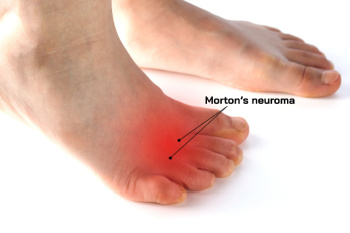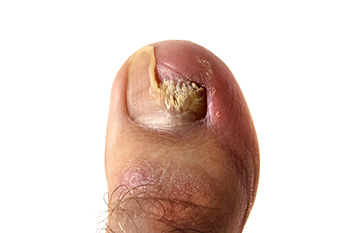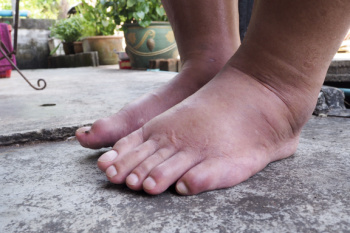Items filtered by date: March 2025
Exercises Can Ease Morton’s Neuroma Pain

Morton’s neuroma affects the ball of the foot, often occurring between the third and fourth toes. Morton’s neuroma develops when the plantar digital nerve becomes compressed. This leads to thickened tissue and causes sharp or burning pain, numbness, or the sensation of a pebble inside the shoe. Exercises can help by improving foot strength, flexibility, and alignment to reduce pressure on the nerve. Toe-spreading exercises encourage natural toe positioning, while stretching the big toe and calf muscles can relieve tension in the forefoot. Strengthening exercises, such as towel curls and single-leg balance drills, help stabilize the foot and distribute weight more evenly during movement. Rolling a ball under the arch of the foot may also aid in reducing discomfort. While these exercises may provide relief, persistent symptoms should not be ignored. A podiatrist can evaluate your symptoms, recommend orthotic support if necessary, and determine whether additional treatment is required. If you have symptoms of Morton's neuroma, it is suggested that you schedule an appointment with a podiatrist for an exam, diagnosis, and treatment options.
Morton’s neuroma is a very uncomfortable condition to live with. If you think you have Morton’s neuroma, contact Neeta Hasmukh, DPM of Total Podiatry. Our doctor will attend to all of your foot care needs and answer any of your related questions.
Morton’s Neuroma
Morton's neuroma is a painful foot condition that commonly affects the areas between the second and third or third and fourth toe, although other areas of the foot are also susceptible. Morton’s neuroma is caused by an inflamed nerve in the foot that is being squeezed and aggravated by surrounding bones.
What Increases the Chances of Having Morton’s Neuroma?
- Ill-fitting high heels or shoes that add pressure to the toe or foot
- Jogging, running or any sport that involves constant impact to the foot
- Flat feet, bunions, and any other foot deformities
Morton’s neuroma is a very treatable condition. Orthotics and shoe inserts can often be used to alleviate the pain on the forefront of the feet. In more severe cases, corticosteroids can also be prescribed. In order to figure out the best treatment for your neuroma, it’s recommended to seek the care of a podiatrist who can diagnose your condition and provide different treatment options.
If you have any questions, please feel free to contact our offices located in San Antonio, Uvalde, and Jourdanton, TX . We offer the newest diagnostic and treatment technologies for all your foot care needs.
When Every Step Hurts

Foot and ankle pain is not just an inconvenience. It is a signal that something is not right. Sometimes, the culprit is as simple as wearing poorly fitting shoes that squeeze, rub, or fail to support your feet properly. Other times, the pain runs deeper. Osteoarthritis wears down cartilage, making movement stiff and achy. Inflammatory arthritis can leave joints swollen, tender, and painfully stiff in the morning. Some conditions go beyond the joints. Connective tissue diseases weaken ligaments and tendons, leading to instability. Poor circulation starves the feet of oxygen, causing cramping and slow healing. Nerve damage, often from diabetes, may bring burning pain, numbness, or tingling that worsens over time. If you have foot or ankle pain that lingers or worsens, it is suggested that you visit a podiatrist who can help pinpoint the problem, and offer solutions for relief.
Arthritis can be a difficult condition to live with. If you are seeking treatment, contact Neeta Hasmukh, DPM from Total Podiatry. Our doctor can provide the care you need to keep you pain-free and on your feet.
Arthritic Foot Care
Arthritis is a term that is commonly used to describe joint pain. The condition itself can occur to anyone of any age, race, or gender, and there are over 100 types of it. Nevertheless, arthritis is more commonly found in women compared to men, and it is also more prevalent in those who are overweight. The causes of arthritis vary depending on which type of arthritis you have. Osteoarthritis for example, is often caused by injury, while rheumatoid arthritis is caused by a misdirected immune system.
Symptoms
- Swelling
- Pain
- Stiffness
- Decreased Range of Motion
Arthritic symptoms range in severity, and they may come and go. Some symptoms stay the same for several years but could potentially get worse with time. Severe cases of arthritis can prevent its sufferers from performing daily activities and make walking difficult.
Risk Factors
- Occupation – Occupations requiring repetitive knee movements have been linked to osteoarthritis
- Obesity – Excess weight can contribute to osteoarthritis development
- Infection – Microbial agents can infect the joints and trigger arthritis
- Joint Injuries – Damage to joints may lead to osteoarthritis
- Age – Risk increases with age
- Gender –Most types are more common in women
- Genetics – Arthritis can be hereditary
If you suspect your arthritis is affecting your feet, it is crucial that you see a podiatrist immediately. Your doctor will be able to address your specific case and help you decide which treatment method is best for you.
If you have any questions, please feel free to contact our offices located in San Antonio, Uvalde, and Jourdanton, TX . We offer the newest diagnostic and treatment technologies for all your foot care needs.
Understanding Toenail Fungus

Toenail fungus is a common problem that many people face. It occurs when a fungus infects the nail, causing thickening, discoloration, and an unpleasant smell. The nail may become brittle, crumbling, or separated from the nail bed. This condition usually develops slowly and might go unnoticed until it worsens. Poor hygiene, damp environments, and minor injuries to the nail can contribute to its development. Over time, the fungus may spread to other nails and parts of the foot. Preventing the spread involves keeping feet clean and dry, wearing well-ventilated shoes, and avoiding sharing nail clippers. Early treatment can stop the infection from progressing and ease discomfort. For any ongoing issues or severe cases, it is suggested that you see a podiatrist for proper care.
For more information about treatment, contact Neeta Hasmukh, DPM of Total Podiatry. Our doctor can provide the care you need to keep you pain-free and on your feet.
Toenail Fungus Treatment
Toenail fungus is a condition that affects many people and can be especially hard to get rid of. Fortunately, there are several methods to go about treating and avoiding it.
Antifungals & Deterrence
Oral antifungal medicine has been shown to be effective in many cases. It is important to consult with a podiatrist to determine the proper regiment for you, or potentially explore other options.
Applying foot powder on the feet and shoes helps keep the feet free of moisture and sweat.
Sandals or open toed shoes – Wearing these will allow air movement and help keep feet dry. They also expose your feet to light, which fungus cannot tolerate. Socks with moisture wicking material also help as well.
If you have any questions please feel free to contact our offices located in San Antonio, Uvalde, and Jourdanton, TX . We offer the newest diagnostic tools and technology to treat your foot and ankle needs.
Uncomfortable Swollen Feet and Ankles

Swollen feet and ankles can occur for various reasons, often resulting from underlying health conditions or physical changes. Pregnancy is a common cause as the body retains more fluid, and the growing uterus places pressure on veins, affecting circulation. Foot and ankle injuries, such as sprains or fractures, can also cause swelling as the body responds to trauma with inflammation. Venous insufficiency occurs when the veins are unable to efficiently return blood to the heart, leading to fluid buildup in the lower legs and feet. Additionally, phlebitis, the inflammation of veins, can also contribute to swelling and discomfort. In each of these cases, swelling is usually accompanied by pain, redness, or warmth. If you have swollen feet or ankles, it is suggested that you consult a podiatrist who can determine what the cause is, and offer effective relief tips.
Swollen feet can be a sign of an underlying condition. If you have any concerns, contact Neeta Hasmukh, DPM of Total Podiatry. Our doctor can provide the care you need to keep you pain-free and on your feet.
Swollen feet are a common ailment among pregnant women and people who stand or sit for extended periods. Aging may increase the possibility of swollen feet and patients who are obese often notice when their feet are swelling too. There may be medical reasons why swollen feet occur:
- Phlebitis - A condition that causes the veins to become inflamed and can also cause leg pain.
- Liver disease - This may lead to low blood levels of albumin which is a protein. This can cause fluid in the blood to pass into the tissues and several areas of the body can become swollen.
- Heart failure - When the heart doesn’t pump properly the blood that is normally pumped back to the heart can pool in the veins of the legs causing swollen feet.
- Kidney disease - One of the main functions of the kidneys is releasing excess fluid in the body. This type of condition can make it difficult for the kidneys to function properly, and as a result the feet may become swollen.
- Deep-vein thrombosis (DVT)- This is a serious condition where blood clots form in the veins of the legs. They can block the return of blood from the legs to the heart which may cause the feet to swell. It is important to be treated by a podiatrist if this condition is present.
Swollen feet can also be caused by bone and tendon conditions, including fractures, arthritis, and tendinitis. Additionally, there may be skin and toenail conditions and an infection may cause the feet to swell. Patients who take medicine to treat high blood pressure may be prone to getting swollen feet.
Many patients elevate their feet to help relieve the swelling and this is generally a temporary remedy. When a podiatrist is consulted the reason behind the swelling can be uncovered and subsequently treated.
If you have any questions please feel free to contact our offices located in San Antonio, Uvalde, and Jourdanton, TX . We offer the newest diagnostic tools and technology to treat your foot and ankle needs.

